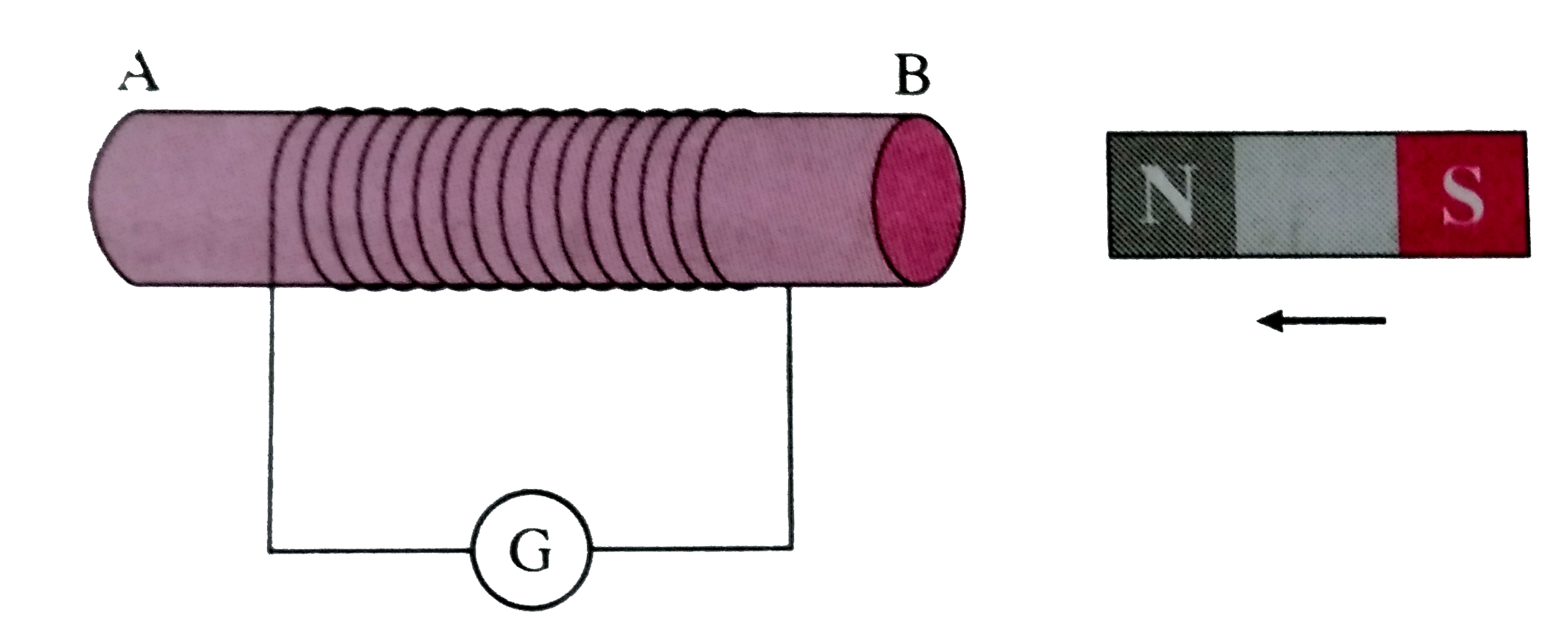Take a coil AB having 10-15 turns. Connect the two ends of the coil to the galvanometer as shown in Fig. Take a strong bar magnet. (1) Move the north pole of the magnet towards the end B of the coil Observe the deflection of the pointer in the galvanometer. Note the direction of the deflection (i.e. right or left). (2) Now repeat this with the south pole of the magnet towards the end B of the coil. Again observe the deflection. Note its direction. (3) What will happen if instead of the magnet, the coil is moved? (4) If both the coil and the magnet are kept stationary, do you observe any deflection? (5) Compare the direction of the deflection when the north pole of the magnet is moved towards the end B of the coil with that when the end B of the coil is moved away from the north pole of the magnet. (6) What conclusions do you draw from the observations?

Text Solution
Observations : The two deflections, in parts (1) and (2) of the experiment, are in the opposite directions. (3) If instead of the magnet, the coil is moved towards the stationary magnet, the deflection of the pointer in the galvanometer is observed in one direction, while if the coil is moved away from the magnet, the deflection is observed in the opposite direction. The effect of moving the north pole of the magnet towards the coil and the effect of moving the coil towards the north pole of the magnet are the same.(4) If both the coil and the magnet are kept stationary, no deflection is observed. (5) The two deflections are in opposite directions. (6) Whenever there is relative motion of the coil and the magnet, electric potential difference is induced in the circuit Wnich gives rise to, ie, induces, an electric current in the circuit causing the deflection of the pointer in the galvanomete The direction of the current and hence that of the deflection of the pointer in the galvanometer depends on which pole of the magnet faces the coil as well as the direction of relative motion.
|
Topper's Solved these Questions
- EFFECTS OF ELECTRIC CURRENT BOOK - NAVNEET PUBLICATION - MAHARASHTRA BOARDCHAPTER - EFFECTS OF ELECTRIC CURRENT EXERCISE - Give scientific reasons :
11 Videos
- EFFECTS OF ELECTRIC CURRENT BOOK - NAVNEET PUBLICATION - MAHARASHTRA BOARDCHAPTER - EFFECTS OF ELECTRIC CURRENT EXERCISE - Distinguish between the following :
3 Videos
- EFFECTS OF ELECTRIC CURRENT BOOK - NAVNEET PUBLICATION - MAHARASHTRA BOARDCHAPTER - EFFECTS OF ELECTRIC CURRENT EXERCISE - Answer the following questions in one sentence each :
4 Videos
- DISTINGUISH BETWEEN THE FOLLOWINGBOOK - NAVNEET PUBLICATION - MAHARASHTRA BOARDCHAPTER - DISTINGUISH BETWEEN THE FOLLOWINGEXERCISE - Animal Classification
1 Videos
- EXPLANATION AND GIVING CONCEPTS BOOK - NAVNEET PUBLICATION - MAHARASHTRA BOARDCHAPTER - EXPLANATION AND GIVING CONCEPTS EXERCISE - ANIMAL CLASSIFICATION
2 Videos
Similar Questions
Knowledge Check
The deflection in moving coil galvanometer is
Adirectly proportional to the torsional constantBinversely proportional to the area of the coilCinversely proportional to the currentDdirectly proportional to the number of turns in the coilThe deflection in a moving coil galvanometer is
ADirectly proportional to the torsional constantBDirectily proportional to the number of torsional coilCInversty proportional to the area of coilDInversely proportional to the current flowingThe deflection in a moving coil galvanometer is
Ainversely proportional to number of turns.Binversely proportional to current flowing.Cinversely proportional to area of the coil.Ddirectly proportional to the magnetic field strength.
The deflection in a moving coil galvanometer is
View SolutionThe pole pieces of the magnet used in a pivoted coil galvanometer are
View SolutionWhen a magnet is moved with its south pole towards the coil, then the nearer face of the coil behaves as a
View SolutionThe pole pieces of the magnet used in a pivoted coil galvanometer are
View SolutionThe pole pieces of the magnet used in a pivoted coil galvanometer are
View Solution
